한국응용과학기술학회 논문 검색
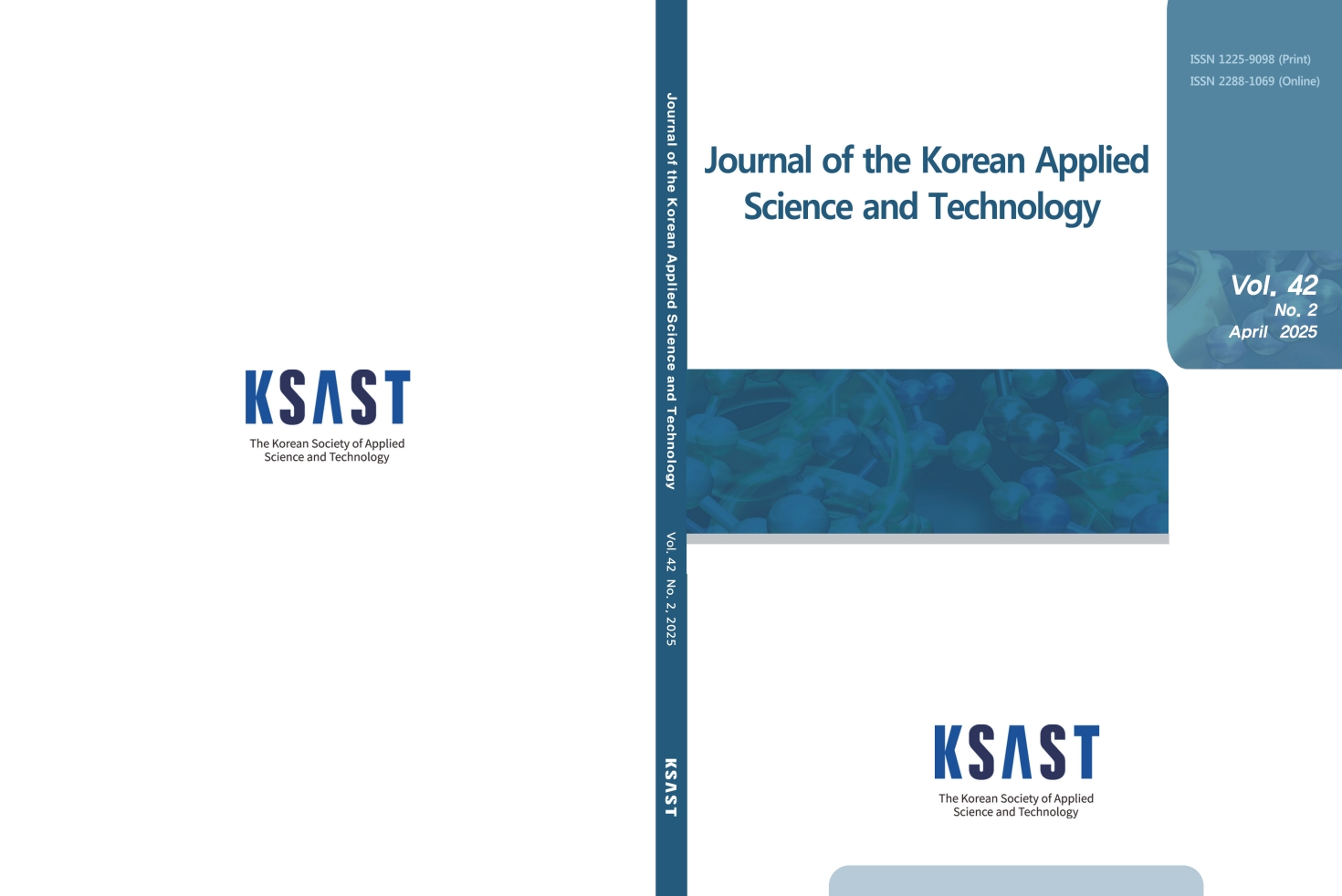
An Analysis on factors reinforcing regional branding of Yangpyeong Yongmunsan Wild Greens Festival
간행물 정보 : Vol. 42 No. 2, 2025년,
파일형식 : pdf

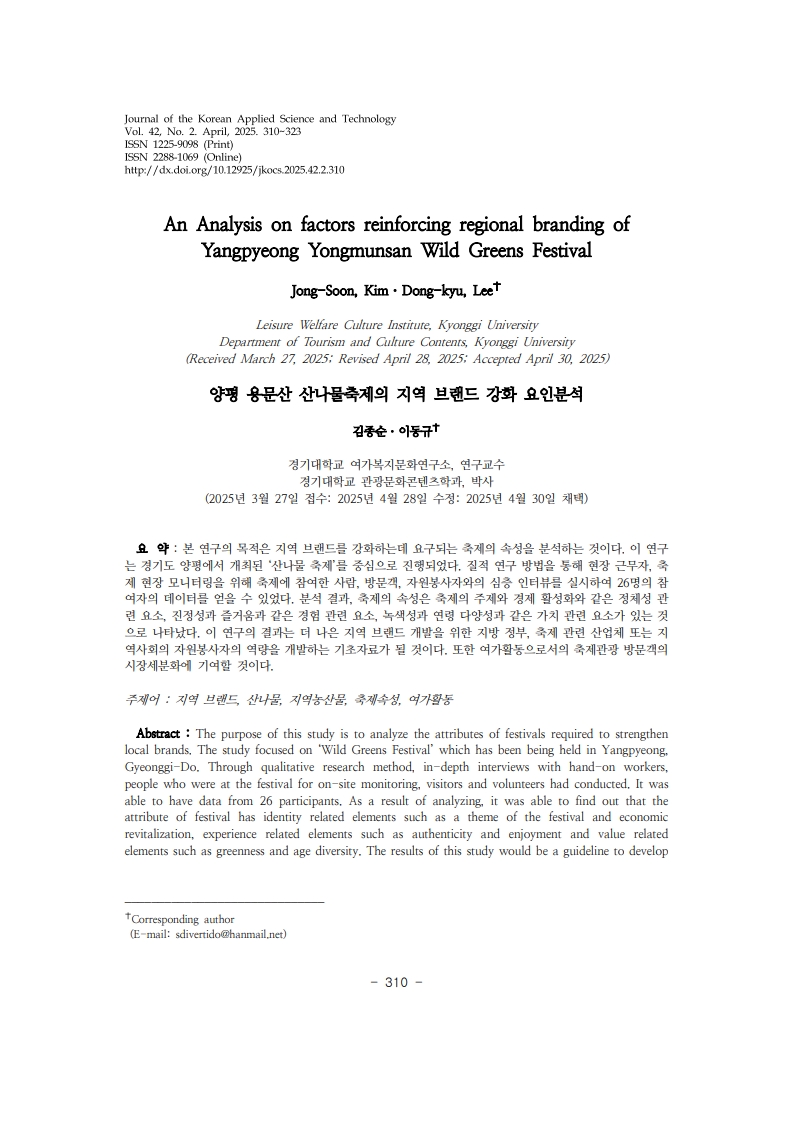

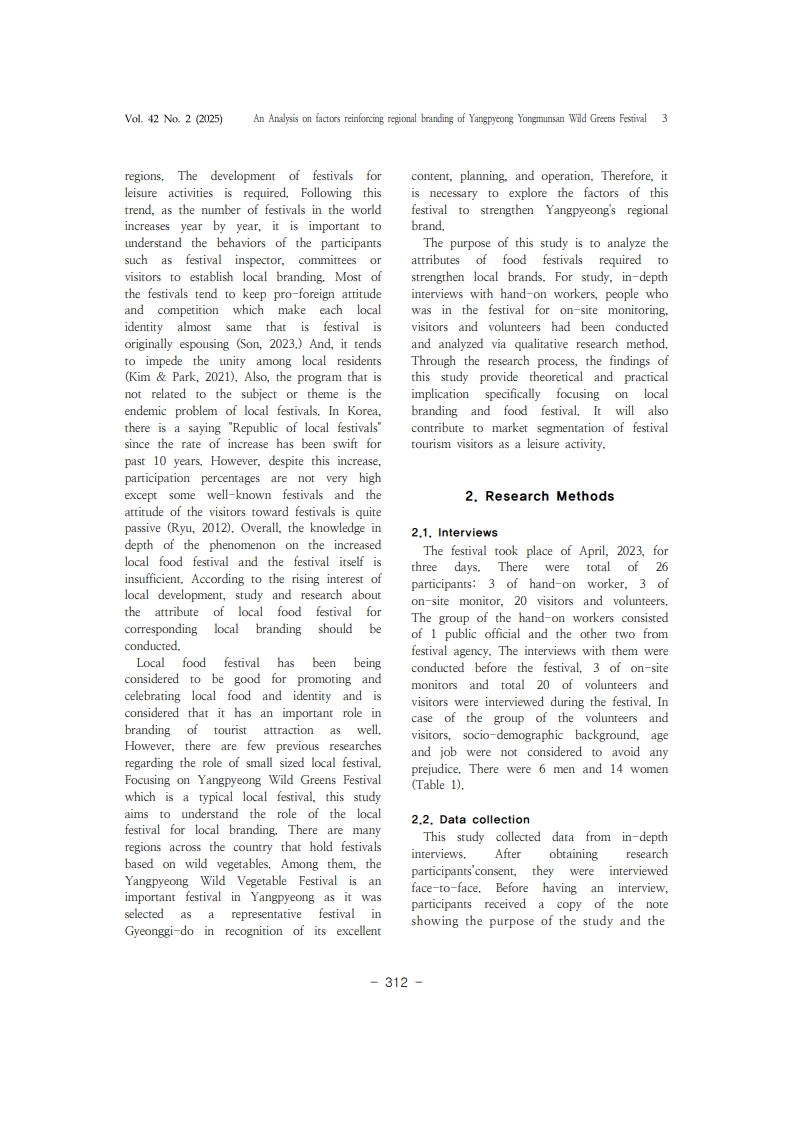

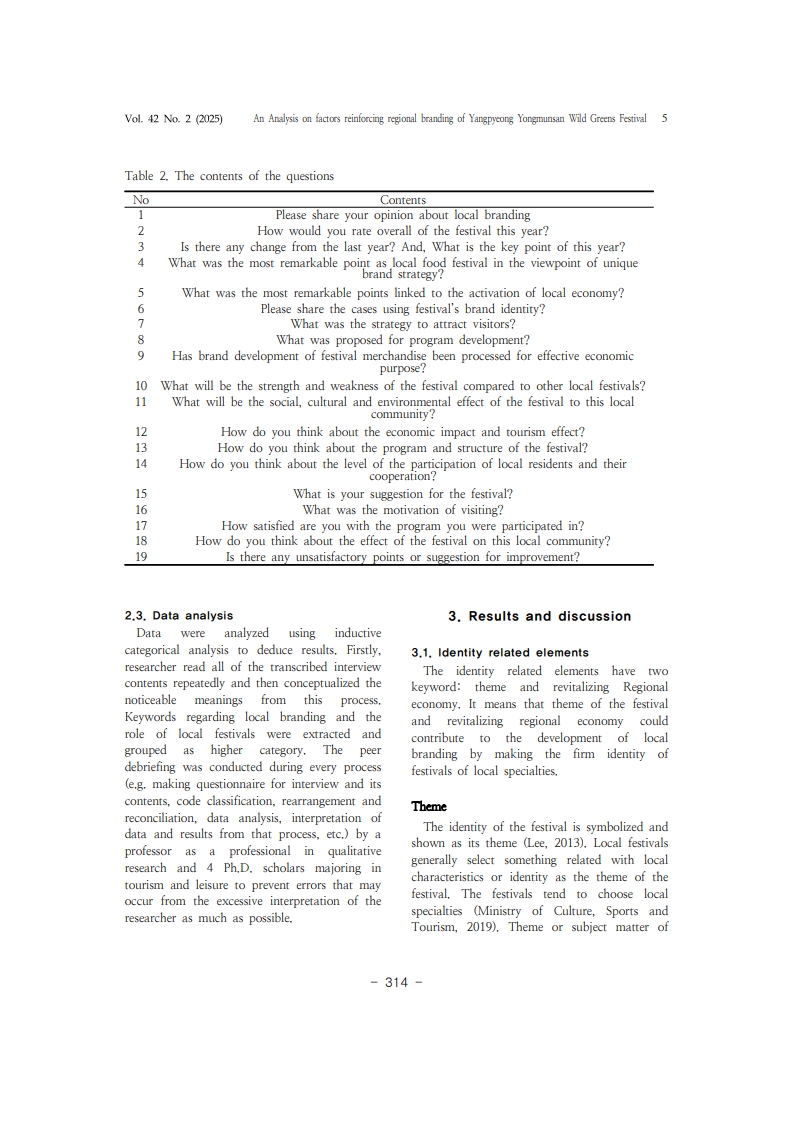
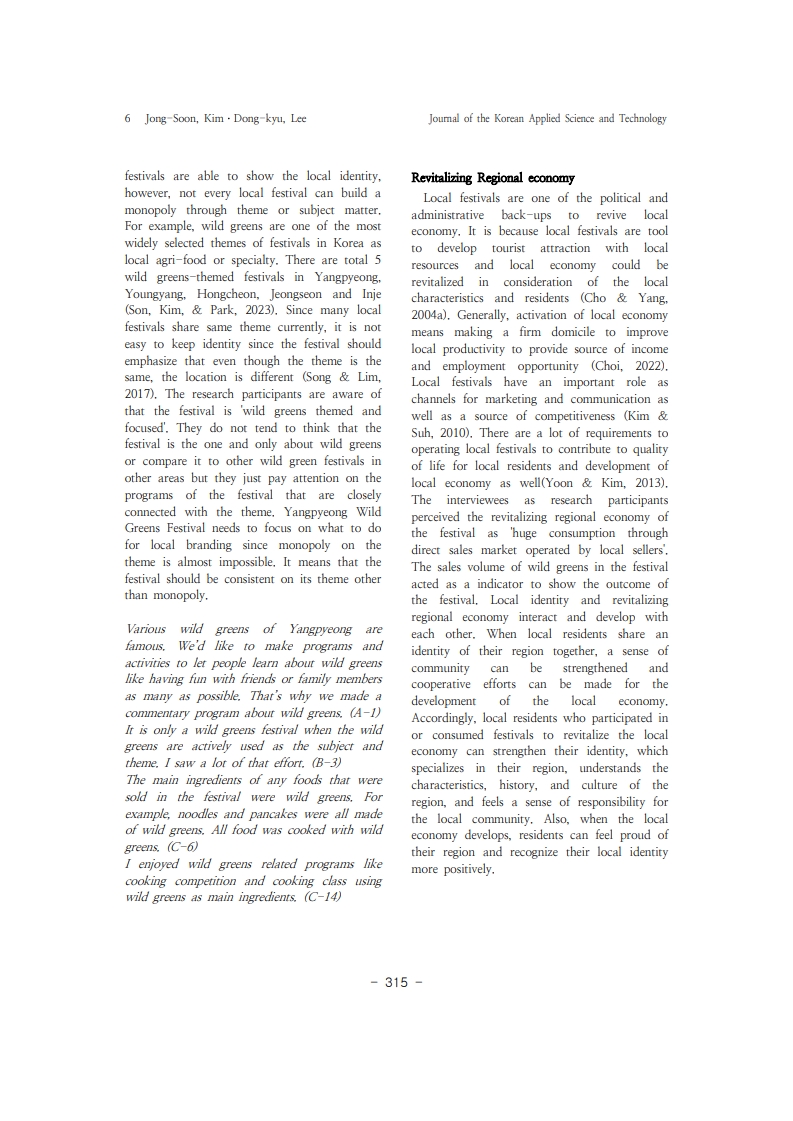
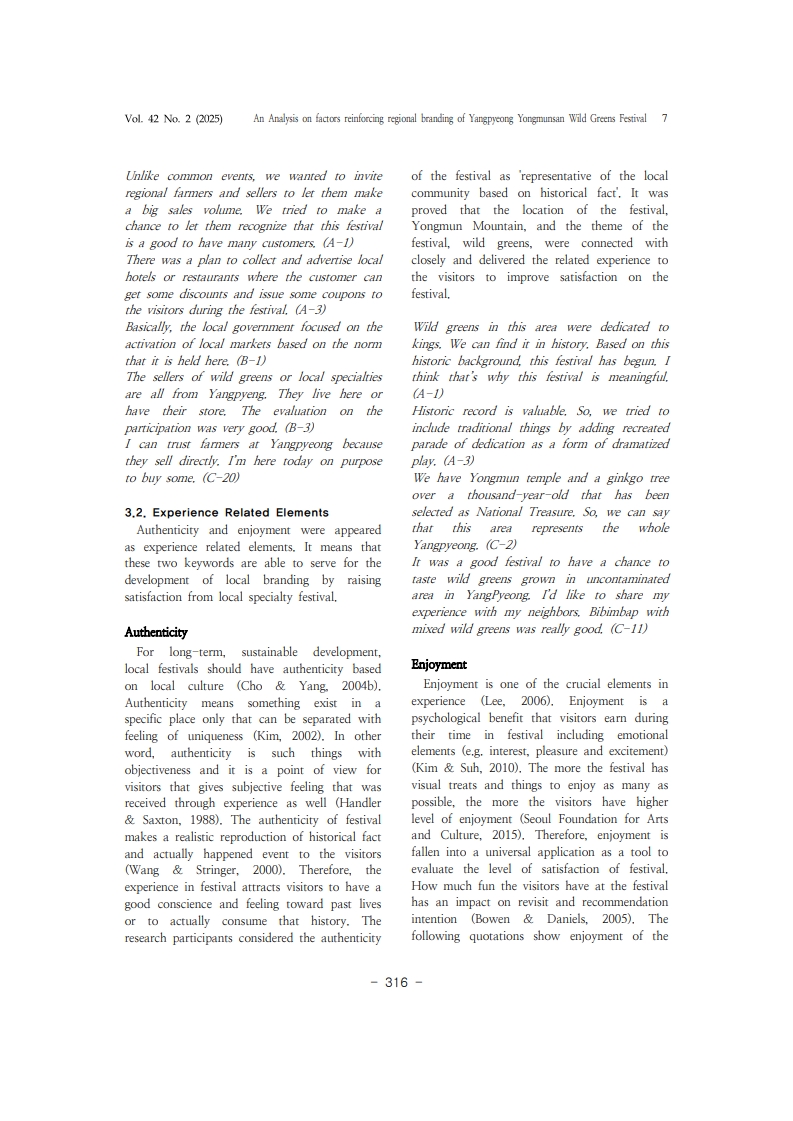

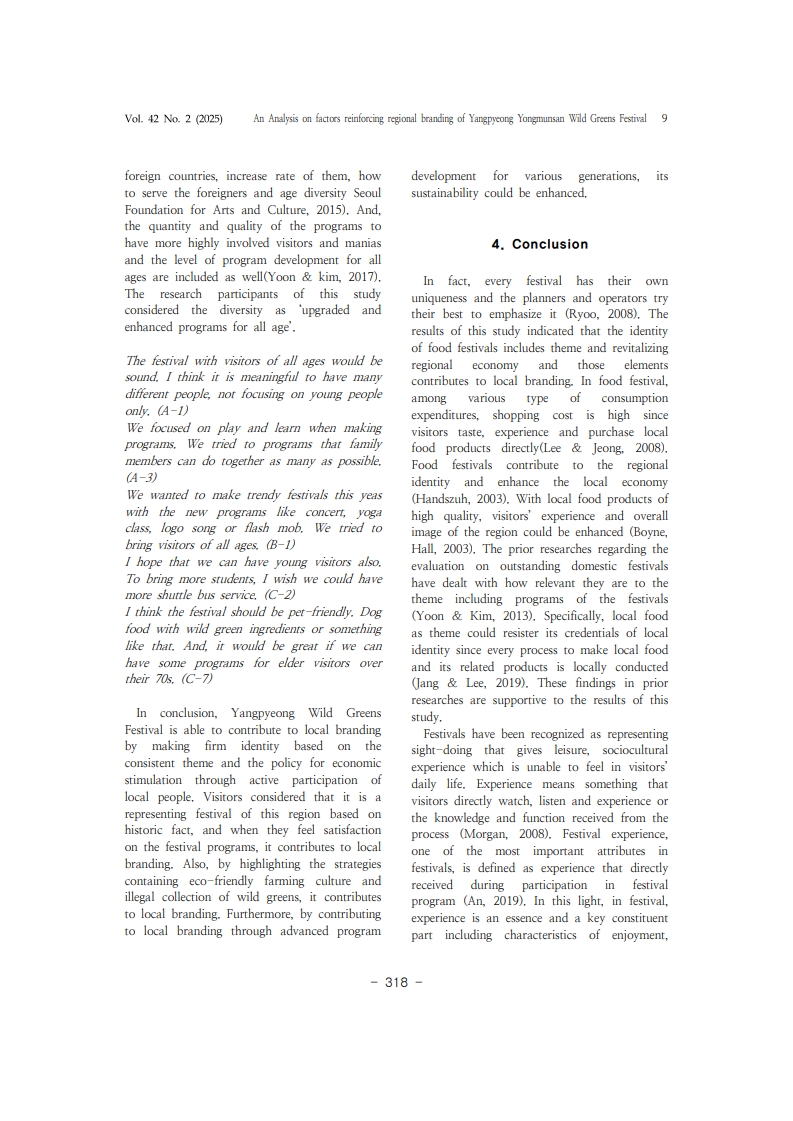
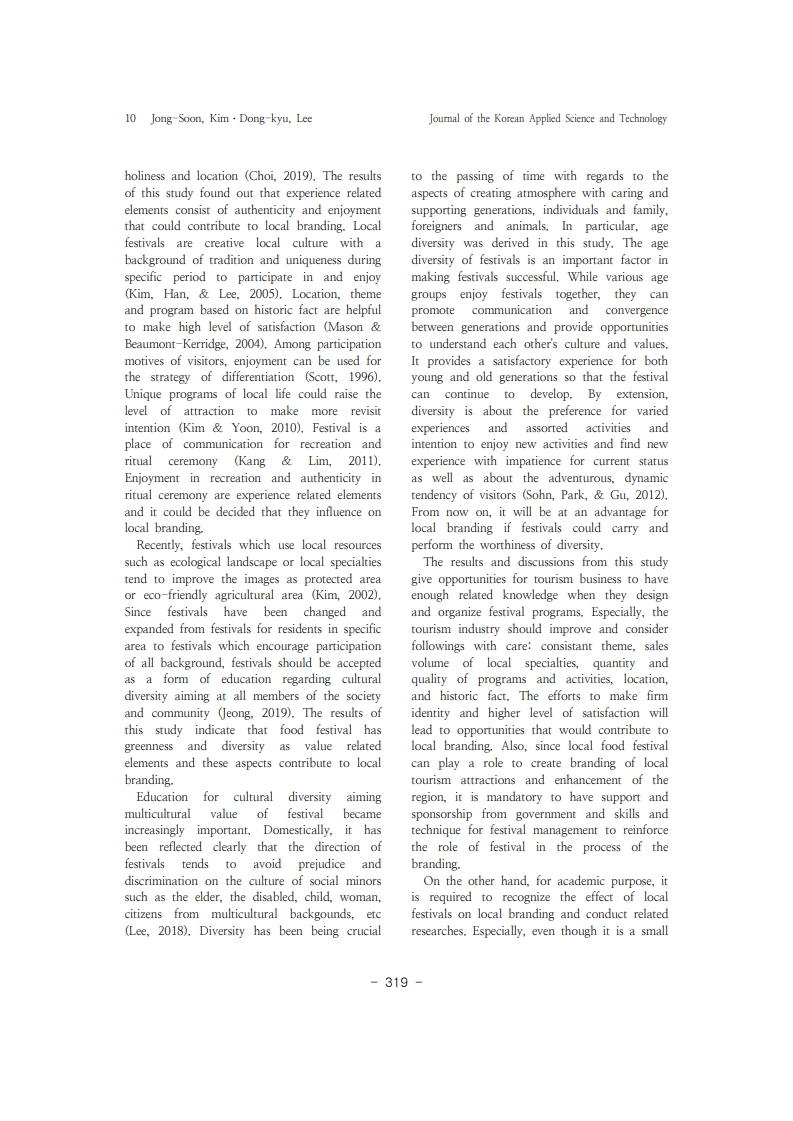
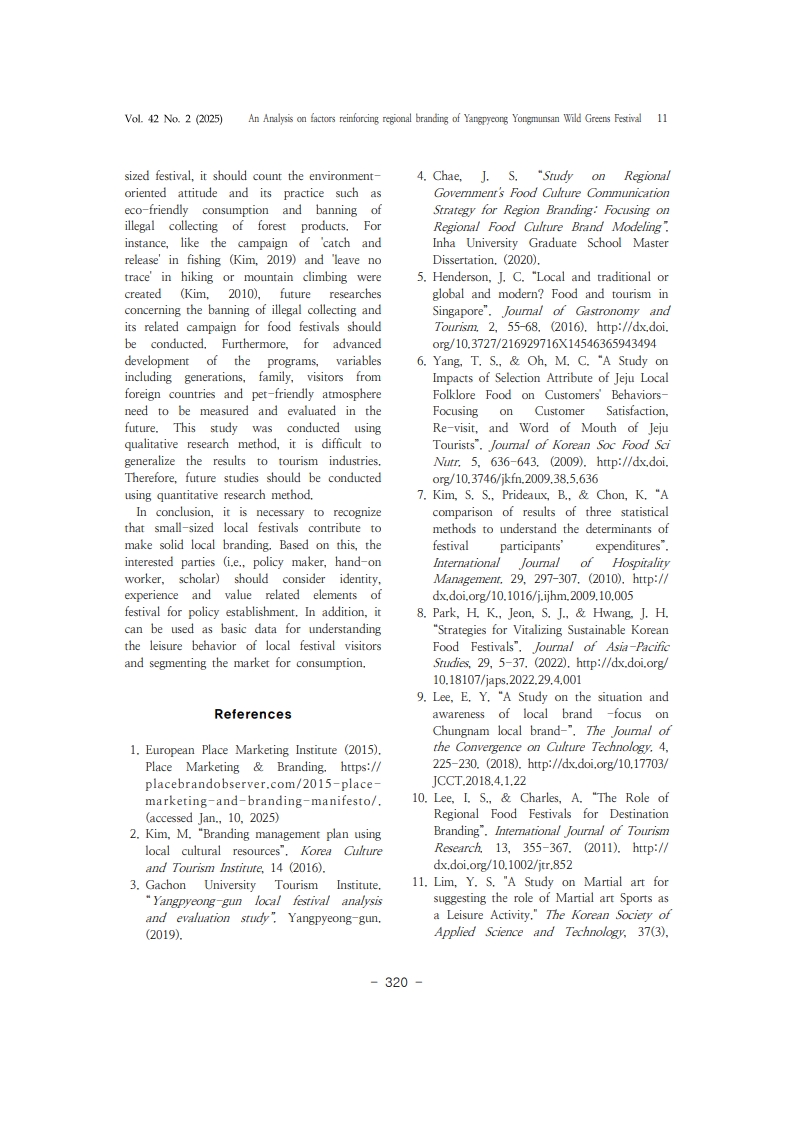
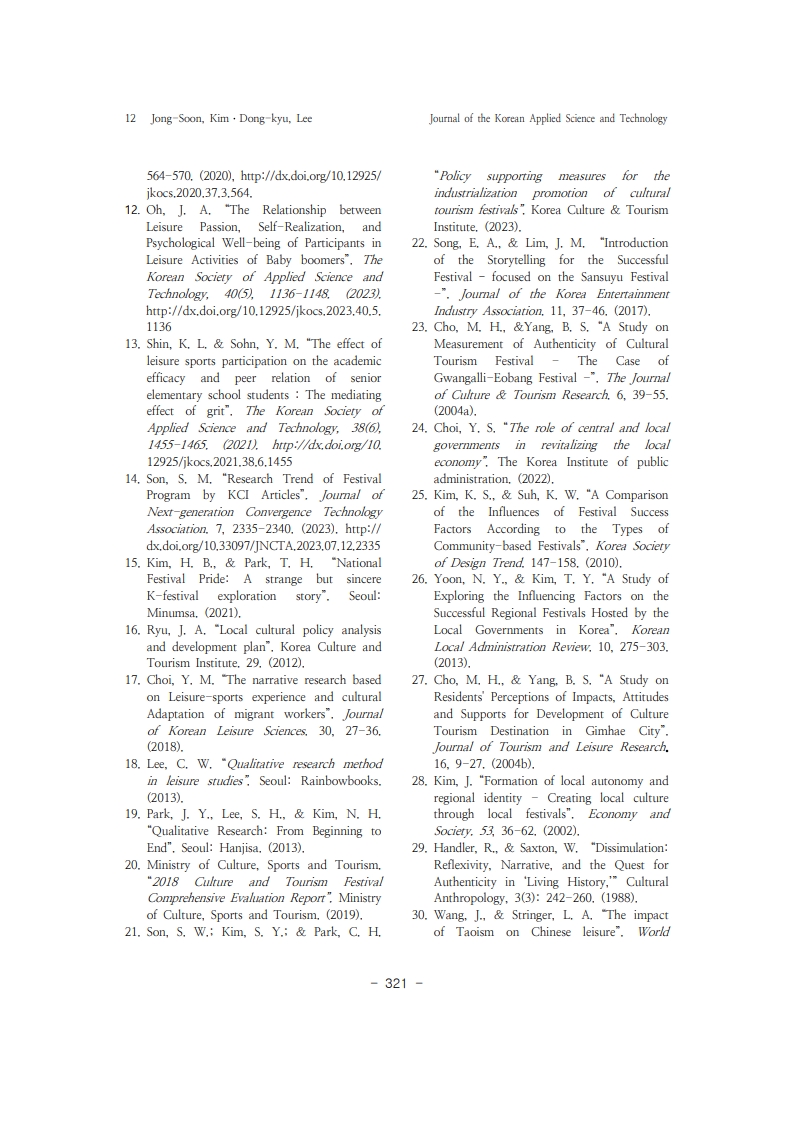
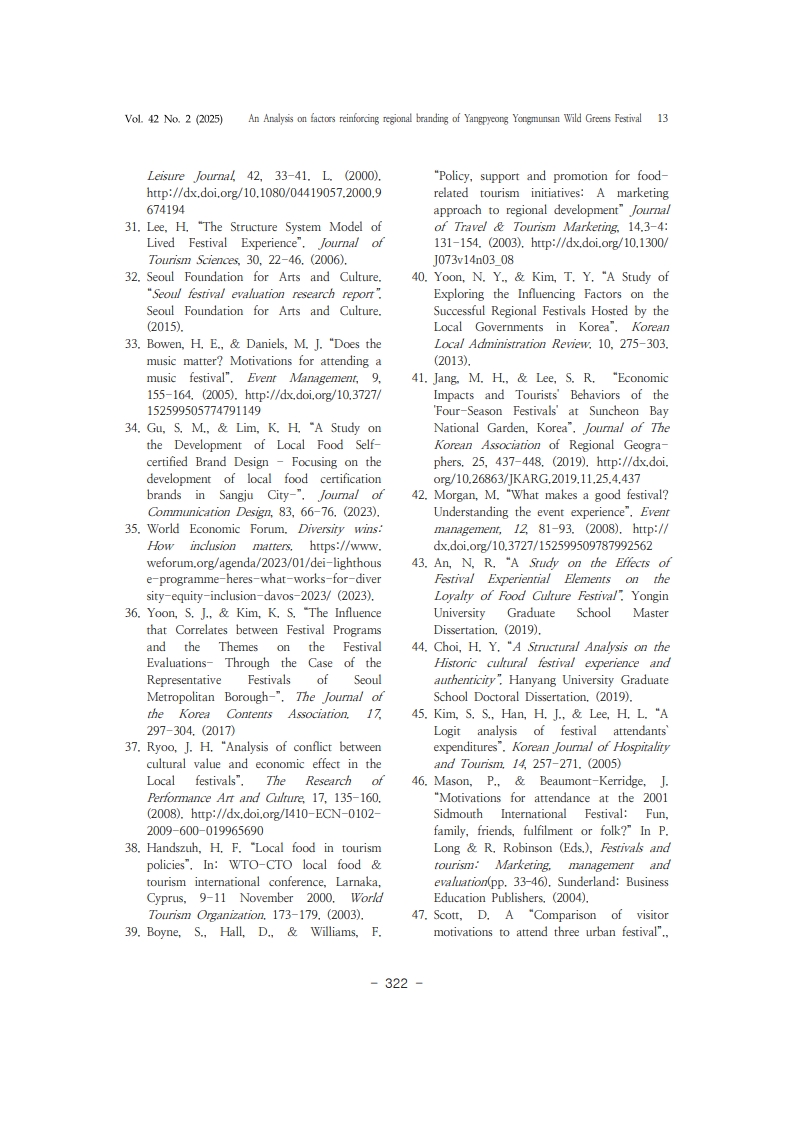
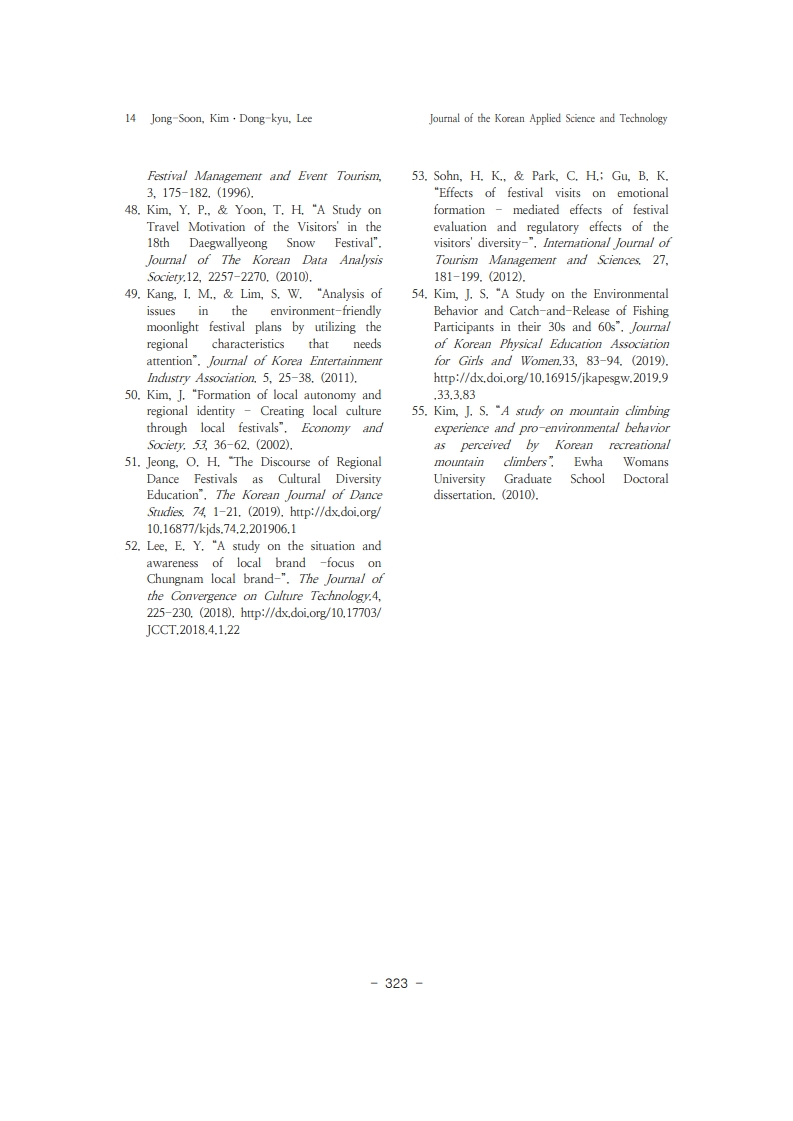 1. European Place Marketing Institute (2015).Place Marketing & Branding.
1. European Place Marketing Institute (2015).Place Marketing & Branding.
https://placebrandobserver.com/2015-placemarketing-and-branding-manifesto/.(accessed Jan., 10, 2025)
2. Kim, M. “Branding management plan using local cultural resources”. Korea Culture and Tourism Institute, 14 (2016).
3. Gachon University Tourism Institute. “Yangpyeong-gun local festival analysis and evaluation study”. Yangpyeong-gun. (2019).
4. Chae, J. S. “Study on Regional Government's Food Culture Communication Strategy for Region Branding: Focusing on Regional Food Culture Brand Modeling”. Inha University Graduate School Master Dissertation. (2020).
5. Henderson, J. C. “Local and traditional or global and modern? Food and tourism in Singapore”. Journal of Gastronomy and Tourism. 2, 55–68. (2016).
http://dx.doi.org/10.3727/216929716X14546365943494
6. Yang, T. S., & Oh, M. C. “A Study on Impacts of Selection Attribute of Jeju Local Folklore Food on Customers' BehaviorsFocusing on Customer Satisfaction, Re-visit, and Word of Mouth of Jeju Tourists”. Journal of Korean Soc Food Sci Nutr. 5, 636-643. (2009). http://dx.doi.org/10.3746/jkfn.2009.38.5.636
7. Kim, S. S., Prideaux, B., & Chon, K. “A comparison of results of three statistical methods to understand the determinants of festival participants’ expenditures”.
International Journal of Hospitality Management. 29, 297–307. (2010). http://dx.doi.org/10.1016/j.ijhm.2009.10.005
8. Park, H. K., Jeon, S. J., & Hwang, J. H. “Strategies for Vitalizing Sustainable Korean Food Festivals”. Journal of Asia-Pacific Studies, 29, 5-37. (2022). ㅊhttp://dx.doi.org/10.1016/j.ijhm.2009.10.005
9. Lee, E. Y. “A Study on the situation and awareness of local brand -focus on Chungnam local brand-”. The Journal of the Convergence on Culture Technology. 4, 225-230. (2018). http://dx.doi.org/10.17703/JCCT.2018.4.1.22
10. Lee, I. S., & Charles, A. “The Role of Regional Food Festivals for Destination Branding”. International Journal of TourismResearch. 13, 355-367. (2011).
http://dx.doi.org/10.1002/jtr.852
11. Lim, Y. S. "A Study on Martial art for suggesting the role of Martial art Sports as a Leisure Activity." The Korean Society of Applied Science and Technology, 37(3), 12 Jong-Soon, Kim․Dong-kyu, Lee J564-570. (2020), http://dx.doi.org/10.12925/jkocs.2020.37.3.564.
12. Oh, J. A. “The Relationship between Leisure Passion, Self-Realization, and Psychological Well-being of Participants in Leisure Activities of Baby boomers”. The
Korean Society of Applied Science and Technology, 40(5), 1136-1148. (2023). http://dx.doi.org/10.12925/jkocs.2023.40.5.1136
13. Shin, K. L. & Sohn, Y. M. “The effect of leisure sports participation on the academic efficacy and peer relation of senior elementary school students : The mediating effect of grit”. The Korean Society of Applied Science and Technology, 38(6), 1455-1465. (2021). http://dx.doi.org/10. 12925/jkocs.2021.38.6.1455
14. Son, S. M. “Research Trend of Festival Program by KCI Articles”. Journal of Next-generation Convergence Technology Association. 7, 2335-2340. (2023).
http://dx.doi.org/10.33097/JNCTA.2023.07.12.2335
15. Kim, H. B., & Park, T. H. “National Festival Pride: A strange but sincere K-festival exploration story”. Seoul: Minumsa. (2021).
16. Ryu, J. A. “Local cultural policy analysis and development plan”. Korea Culture and Tourism Institute. 29. (2012).
17. Choi, Y. M. “The narrative research based on Leisure-sports experience and cultural Adaptation of migrant workers”. Journal of Korean Leisure Sciences. 30, 27-36. (2018).
18. Lee, C. W. “Qualitative research method in leisure studies”. Seoul: Rainbowbooks. (2013).
19. Park, J. Y., Lee, S. H., & Kim, N. H. “Qualitative Research: From Beginning to End”. Seoul: Hanjisa. (2013).
20. Ministry of Culture, Sports and Tourism. “2018 Culture and Tourism Festival Comprehensive Evaluation Report”. Ministryof Culture, Sports and Tourism. (2019).
21. Son, S. W.; Kim, S. Y.; & Park, C. H. “Policy supporting measures for the industrialization promotion of cultural tourism festivals”. Korea Culture & Tourism
Institute. (2023).
22. Song, E. A., & Lim, J. M. “Introduction of the Storytelling for the Successful Festival – focused on the Sansuyu Festival -”. Journal of the Korea Entertainment
Industry Association. 11, 37-46. (2017).
23. Cho, M. H., &Yang, B. S. “A Study on Measurement of Authenticity of Cultural Tourism Festival - The Case of Gwangalli-Eobang Festival -”. The Journal
of Culture & Tourism Research. 6, 39-55. (2004a).
24. Choi, Y. S. “The role of central and local governments in revitalizing the local economy”. The Korea Institute of public administration. (2022).
25. Kim, K. S., & Suh, K. W. “A Comparison of the Influences of Festival Success Factors According to the Types of Community-based Festivals”. Korea Society
of Design Trend. 147-158. (2010).
26. Yoon, N. Y., & Kim, T. Y. “A Study of Exploring the Influencing Factors on the Successful Regional Festivals Hosted by the Local Governments in Korea”. Korean
Local Administration Review. 10, 275-303. (2013).
27. Cho, M. H., & Yang, B. S. “A Study on Residents' Perceptions of Impacts, Attitudes and Supports for Development of Culture Tourism Destination in Gimhae City”. Journal of Tourism and Leisure Research. 16, 9-27. (2004b).
28. Kim, J. “Formation of local autonomy and regional identity - Creating local culture through local festivals”. Economy and Society. 53, 36-62. (2002).
29. Handler, R., & Saxton, W. “Dissimulation: Reflexivity, Narrative, and the Quest for Authenticity in ‘Living History,’” Cultural Anthropology, 3(3): 242-260. (1988).
30. Wang, J., & Stringer, L. A. “The impact of Taoism on Chinese leisure”. World Vol. 42 No. 2 (2025) An Analysis on factors reinforcing regional branding of Yangpyeong Yongmunsan Wild Greens Festival 13Leisure Journal, 42, 33-41. L. (2000). http://dx.doi.org/10.1080/04419057.2000.9674194
31. Lee, H. “The Structure System Model of Lived Festival Experience”. Journal of Tourism Sciences, 30, 22-46. (2006).
32. Seoul Foundation for Arts and Culture. “Seoul festival evaluation research report”. Seoul Foundation for Arts and Culture. (2015).
33. Bowen, H. E., & Daniels, M. J. “Does the music matter? Motivations for attending a music festival”. Event Management, 9, 155-164 (2005). http://dx.doi.org/10.3727/152599505774791149
34. Gu, S. M., & Lim, K. H. “A Study on the Development of Local Food SelfcertifiedBrand Design - Focusing on the development of local food certification brands in Sangju City-”. Journal of Communication Design, 83, 66-76. (2023).
35. World Economic Forum. Diversity wins: How inclusion matters.
36. Yoon, S. J., & Kim, K. S. “The Influence that Correlates between Festival Programs and the Themes on the Festival Evaluations- Through the Case of the
Representative Festivals of Seoul Metropolitan Borough-”. The Journal of the Korea Contents Association. 17, 297-304. (2017)
37. Ryoo, J. H. “Analysis of conflict between cultural value and economic effect in the Local festivals”. The Research of Performance Art and Culture, 17, 135-160.
(2008). http://dx.doi.org/I410-ECN-0102-2009-600-019965690
38. Handszuh, H. F. “Local food in tourism policies”. In: WTO-CTO local food &tourism international conference, Larnaka, Cyprus, 9-11 November 2000. World
Tourism Organization. 173-179. (2003).
39. Boyne, S., Hall, D., & Williams, F. “Policy, support and promotion for foodrelatedtourism initiatives: A marketing approach to regional development” Journal of Travel & Tourism Marketing, 14.3-4: 131-154. (2003). http://dx.doi.org/10.1300/J073v14n03_08
40. Yoon, N. Y., & Kim, T. Y. “A Study of Exploring the Influencing Factors on the Successful Regional Festivals Hosted by the Local Governments in Korea”. Korean
Local Administration Review. 10, 275-303. (2013).
41. Jang, M. H., & Lee, S. R. “Economic Impacts and Tourists' Behaviors of the'Four-Season Festivals' at Suncheon Bay National Garden, Korea”. Journal of The
Korean Association of Regional Geographers.25, 437-448. (2019).http://dx.doi.org/10.26863/JKARG.2019.11.25.4.437
42. Morgan, M. “What makes a good festival? Understanding the event experience”. Event management, 12, 81-93. (2008).
http://dx.doi.org/10.3727/152599509787992562
43. An, N, R. “A Study on the Effects of Festival Experiential Elements on theLoyalty of Food Culture Festival”. Yongin University Graduate School Master
Dissertation. (2019).
44. Choi, H. Y. “A Structural Analysis on the Historic cultural festival experience and authenticity”. Hanyang University Graduate School Doctoral Dissertation. (2019).
45. Kim, S. S., Han, H. J., & Lee, H. L. “A Logit analysis of festival attendants` expenditures”. Korean Journal of Hospitalityand Tourism. 14, 257-271. (2005)
46. Mason, P., & Beaumont-Kerridge, J. “Motivations for attendance at the 2001 Sidmouth International Festival: Fun, family, friends, fulfilment or folk?” In P.Long & R. Robinson (Eds.), Festivals and tourism: Marketing, management and evaluation(pp. 33–46). Sunderland: Business Education Publishers. (2004).
47. Scott, D. A “Comparison of visitor motivations to attend three urban festival”.Festival Management and Event Tourism, 3, 175-182. (1996).
48. Kim, Y. P., & Yoon, T. H. “A Study on Travel Motivation of the Visitors' in the 18th Daegwallyeong Snow Festival”. Journal of The Korean Data Analysis
Society.12, 2257-2270. (2010).
49. Kang, I. M., & Lim, S. W. “Analysis of issues in the environment-friendly moonlight festival plans by utilizing the regional characteristics that needs
attention”. Journal of Korea Entertainment Industry Association. 5, 25-38. (2011).
50. Kim, J. “Formation of local autonomy and regional identity - Creating local culture through local festivals”. Economy and Society. 53, 36-62. (2002).
51. Jeong, O. H. “The Discourse of Regional Dance Festivals as Cultural Diversity Education”. The Korean Journal of Dance Studies. 74, 1-21. (2019). http://dx.doi.org/10.16877/kjds.74.2.201906.1
52. Lee, E. Y. “A study on the situation and awareness of local brand -focus on Chungnam local brand-”. The Journal of the Convergence on Culture Technology.4, 225-230. (2018). http://dx.doi.org/10.17703/JCCT.2018.4.1.22
53. Sohn, H. K., & Park, C. H.; Gu, B. K. “Effects of festival visits on emotional formation - mediated effects of festival evaluation and regulatory effects of the
visitors' diversity-”. International Journal of Tourism Management and Sciences. 27, 181-199. (2012).
54. Kim, J. S. “A Study on the Environmental Behavior and Catch-and-Release of FishingParticipants in their 30s and 60s”. Journal of Korean Physical Education Association for Girls and Women.33, 83-94. (2019). http://dx.doi.org/10.16915/jkapesgw.2019.9.33.3.83
55. Kim, J. S. “A study on mountain climbing experience and pro-environmental behavior as perceived by Korean recreational mountain climbers”. Ewha Womans
University Graduate School Doctoral dissertation. (2010).
